Superfish, Privdog and other Scary Beasts
You may have heard something about Lenovo computers and something called “Superfish”. (If you’ve actually heard of “Privdog”, you can skip the rest of this article – you’re already well ahead of the game.)
(more…)
Mailbox Management
I received an email the other day and sent a response. A few minutes after I had submitted my reply I received an auto-reply from the mail server saying:

A “full mailbox”: one of the banes of our existence. At OkState, when our mailboxes get full we can no longer send or receive emails, and this can make communication slightly painful. Nothing can get on your nerves faster than trying to send an important email only to have it bounce back as undeliverable. Most email services typically set a limit on the size of your email mailbox. Google gives you 15GBs to share across all their services and Yahoo has a limit of 1TB (1000GB). OkState provides a default mailbox size of 500MB. “But Andrew”, I hear you say, “500MB is not that much!” Well, on one hand, that is correct; however, with proper mailbox management you should find that 500MB is sufficiently large. Hopefully, in this post I will give you some ideas on how you can manage your mailbox.
(more…)
Hello Barbie and the Internet of Things
“I hear the secrets that you keep/When you’re talking in your sleep.”
–The Romantics
Hello Barbie is Mattel’s newest Barbie doll; the company demonstrated the doll at the New York Toy Fair in February and plans to begin selling it this fall.. Mattel says that the doll was designed in response to its marketing surveys, which indicated that the thing most little girls wanted was to be able to talk to their Barbies. Hello Barbie can not only talk, she can talk about the things her owners are discussing. How? The doll has a microphone that can record speech when a button is pressed. The recording is then transmitted over Wi-Fi to the Internet, processed and analyzed, and then Barbie says something in response. This is similar to the way Siri works, but it’s the first time it’s been done to a toy.
So just to make it simple:
- This doll records conversations around it when a button is pressed.
- The recordings are sent to a company’s servers.
- Speech analysis determines what is being said.
- An appropriate response is sent back to the doll.
This is all part of the Internet of Things (IoT)”, a term you’ve probably heard recently. The idea is that the Internet, once a way of hooking together computers to share information, will now also become a way of connecting almost every item we use. This way, we’ll all have access to important information at any time, and we’ll be able to control our devices from almost anywhere. There are some real benefits to the idea. Controlling your heating/cooling system to make sure your house is at a comfortable temperature when you’re there becomes much easier and more efficient. Devices that are wearing out can report their status so you don’t get caught by unexpected failures. There also some very serious privacy concerns as well, however.
In the case of Hello Barbie, I wonder what else Mattel will do with the data generated from the recorded conversations. Will the company use it for marketing? (I’d be surprised if it doesn’t.) Who controls it – Mattel, the company’s partner or someone else? What safeguards are there to keep Hello Barbie’s data secure as it travels from the doll to the Internet and back?
ToyTalk has addressed some of these concerns, but has it done enough? I don’t know. I know what the company has said, and I know how much I trust large corporations to keep their word when there’s a strong financial incentive to break it. And even if it does do what it has said, I know how endlessly creative the hackers are and how insecure much of the infrastructure of the Internet is.
As we implement more and more of the Internet of Things, we’re going to see more security holes. We need to think about each new thing we connect to be sure it’s safe, whether it’s a television or a doll.
Ordering a New Computer
Purchasing a new computer can be an exciting thing, especially for someone using a computer that is slow, not working right or is quite honestly a dinosaur.
Recently I have received several requests for quotes for new computers. In each case, the person requesting the quote has simply requested “a quote for a new computer”. While we almost always include some standard features, such as amount of memory, length of warranty, operating system, and installed software, it is often helpful to have an idea of what the user’s needs are including budget considerations, type of computer (laptop, desktop) and any accessories they want. Here is an idea of what information to include in a quote request to better help your support specialist find the best computer for your needs.
The first question that needs to be answered is what kind of computer you are looking at purchasing, whether a desktop computer, a laptop to replace the desktop so that you can take your computer everywhere you go, or a laptop that will be used for presentations and meetings. The typical request is for a desktop computer. Desktop computers come in a variety of sizes and can be adjusted to your work environment. That said, in most cases, a mini-tower is preferred because it offers a wider range of possibilities for upgrading memory and hard-drive storage space. However, a small form factor can save on desk space and still offer a few spaces for upgrades. In most cases, the smaller model size will cost a little bit more than going with the mini-tower option.
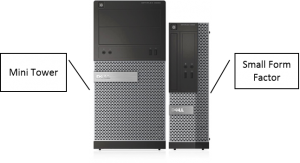
When requesting a laptop, it is helpful to have an idea of what the laptop is going to be used for. For some, it is a secondary computer used for meetings and presentations. The user may not have a need for a lot of storage space but wants to have a portable device they can easily travel with. If this is the case, often the size and weight are of significant importance. Consider a 12 inch, 14 inch or 15 inch screen when considering the size. A standard laptop is around 14 inches and can weigh 3-5 pounds.
The other option is a desktop-replacement laptop, meaning the laptop becomes the user’s primary computer. When looking at this possibility, it is important the specs are similar to that of a desktop computer with plenty of memory and storage on the hard drive as well as a good processor. These are places that are we can cut corners and save some money when looking at a laptop for presenting, but not a place to cut costs when using it as the main computer.
If you are considering a desktop-replacement laptop, a common accessory is a docking station. By connecting the docking station and the laptop, you have access to more USB ports, additional monitors, keyboards and mice, as well as network connection. Most importantly, it make it easy to disconnect your laptop when you get ready to take it on the road.
It is also helpful to have an idea of the budget you have in mind. Recently, I quoted a new computer for less than $1200. This computer included an i7 processor, 16GB of memory, a hard drive with 500GB of storage, a 4 year warranty and a 22 inch monitor. However, if $1200 is too much, alterations can be made to the configuration to help match the individual’s needs such as removing the monitor or reducing the amount of memory.
Another thing to consider is accessories, like a new mouse or keyboard. Most come with this option, but perhaps you want to upgrade to a wireless or ergonomic keyboard and mouse. A new monitor is also something to consider. If you are wanting a larger screen, or the option of dual monitors, adding a new monitor to the list of “wants” is a good idea. However, if you already have two large monitors, having that option added may not be of much use.
As the fiscal year is coming to a close, upgrading your computer is a great place to spend excess money. If you are interested in purchasing a new computer, contact your Support Specialist. Our goal is to find you a great computer that still fits within your budget.
Cynthia Hobbs
DASNR IT
Free Software
“Sign upon the dotted line … nothing’s free. Eventually, nothing’s free.”
–Alice Cooper
Free software is a cool thing. It’s nice when you identify something you need to do (convert a file type, etc.) and then find a good, free tool for doing it. And, of course, a great deal of what we do with computers relies on free software, from Adobe’s PDF reader to Java, from Microsoft Security Essentials to Firefox or Chrome.
There are a couple of problems with free software, though. One is that malware profiteers know that people who are looking for free software can be tricked into downloading malware, so they create sites to take advantage of people who are Googling terms like “free Acrobat” (or other software names). Since you’re expecting to download and run an installer, all they have to do is lie about what you’re getting. One of the tip-offs that you may be getting tricked is the download link. Is it actually from the manufacturer of the software? For example, is your Acrobat download from adobe.com or adobe-pro.softonic.com? There’s a difference (see this article if you want more information), and you want to make sure you’re on the right site. I’ve seen about five different people in the last month who have infected their machines by trying to find free software; in every case, the software was something that our regular NiNite installer would have installed for them.
Another issue is that a lot of free software is now getting bundled with adware and other unwanted programs, even if you download it directly from the maker. So you download your free software and run the installer, and it installs the thing you were trying to get – and also some adware, some fake anti-malware and some system tools that only slow your computer down. Now you’ve got pop-ups and fake anti-malware giving you warnings and asking for your credit card number, and all you wanted to do was to read a PDF.
This is another thing that NiNite was designed to do: Install software without the add-ons. Some of you have probably used our NiNite installer for the free tools we use in OCES. It’s a convenient way to install or update these items. You can also build your own at Ninite.com, if the one on our site doesn’t have what you’re looking for.
If you need something that NiNite doesn’t offer, contact us; we often know about tools that may help you out. We can also check out tools that you’ve found and make sure they don’t install anything bad. Free software is something we all need to use, but it’s not worth messing up your computer.
Windows 7 and beyond: Useful Features
It is very easy to get caught up in the hype of new operating systems about to be released, like Microsoft Windows 10. Sometimes it is so easy to look forward at some of the new features that we forget about some of the great features that are included in Windows 7. Here are five useful features of Windows 7. All of these should be available in Windows 8 and 10.
- Sticky Notes is a great tool that allows you to leave notes on your desktop for a later date. You can resize the notes, change their color and create as many as you need. The notes will not be removed, even if you restart your computer, until you manually choose to delete the individual notes. Sticky Notes are located in the start menu under accessories (if they are not listed, simply type Sticky Notes into the search bar.)
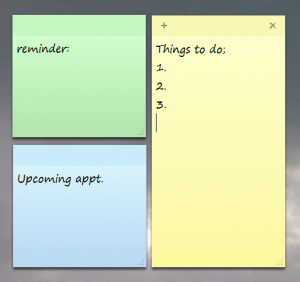
- Snipping Tool can be very handy when you are working on a presentation and need to include an image of an open program or a picture that is open in a browser. When you select the Snipping Tool, it will grey out the screen and change your cursor into a plus cursor. You can then click and drag the cursor over the area you would like to capture. It will then open the Snipping Tool window with the new image in it. If you need to, you can write on or highlight something on the image. When you are finished with the image, you can choose to copy the image and paste it into any other program, email the image, or save the image to your computer.
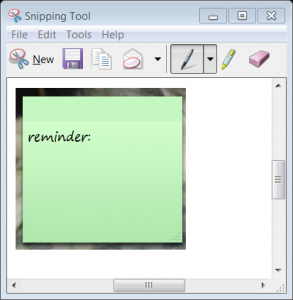
- Search programs and files. This program is fairly self-explanatory, however it can be very powerful if used correctly. As the title says, this tool searches for both files and programs. If you do not see the specific file or program that you are looking for in the initial results, you can select the header to show more of those similar items. For instance, if you are looking for a document and it does not show in the list, you can click the Documents heading to view a search window looking for a document of the name you provided (in the image to the right, the window open is searching for anything with Outlook in the name.)
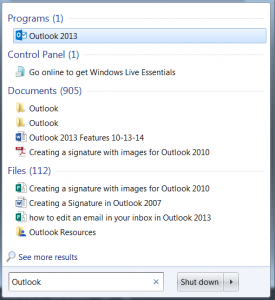
- Windows Snapping. If you need to work with two items open at the same time and only have one monitor, Microsoft has come up with a solution that will help. If you select the first window, press and hold the windows key, and then press the arrow keys to the right or left, it will snap that specific window to that half of the screen. Do the same process with the second monitor and choose the opposite arrow key and you will then have two windows open each sharing the monitor.
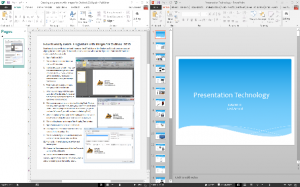
- Pin to Taskbar is a great option for programs that you use very frequently. As there is limited space on the task bar, this is best reserved for programs that you use most frequently. To pin a program to the taskbar, find the program in your start menu, right click on it, and choose Pin to Taskbar. After the program is pinned, you can then right click on any pinned program and see your most recent opened items. This makes it very easy to access a document that you use frequently.
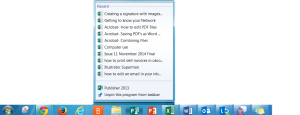
By Levi Arnold
DASNR IT
Digital Signage – Part 1 Overview
Digital Signage – Part 1 Overview
A few years ago the Student Technology Fee Committee of the College of Ag Sciences and Natural Resources agreed to install five digital signage kiosks throughout buildings that housed our academic departmental faculty, staff, and students. The expectation was that these kiosks would provide information about the college and distribute information from the college’s Student Success Center.
Since its original inception, the technology has changed and the kiosks have evolved. Over the next few weeks I will be discussing digital signage, beginning with a simple definition and an overview of the basics of a digital sign solution, and compare the college’s old with our current system. Continue reading after the jump.